In its September 5, 1997, issue, the famous journal Science published an article revealing that Haeckel's embryo drawings had been falsified. The article described how the embryos were in fact very different from one another.
In the preceding sections, we examined the inconsistencies and difficulties the theory of evolution finds itself in in the fields of paleontology and molecular biology in the light of scientific proof and discoveries. In this chapter, we shall be considering some biological facts presented as evidence for the theory in evolutionist sources. In contrast to widespread belief, these facts show that there is actually no scientific discovery that supports the theory of evolution.
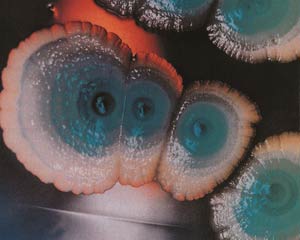
Bacteria quickly become immune to antibiotics by transferring their resistance genes to one another. The picture above shows a colony of E. coli bacteria.
One of the biological concepts that evolutionists try to present as evidence for their theory is the resistance of bacteria to antibiotics. Many evolutionist sources mention antibiotic resistance as "an example of the development of living things by advantageous mutations." A similar claim is also made for the insects which build immunity to insecticides such as DDT.
However, evolutionists are mistaken on this subject too.
Antibiotics are "killer molecules" that are produced by microorganisms to fight other microorganisms. The first antibiotic was penicillin, discovered by Alexander Fleming in 1928. Fleming realized that mould produced a molecule that killed the Staphylococcus bacterium, and this discovery marked a turning point in the world of medicine. Antibiotics derived from microorganisms were used against bacteria and the results were successful.
Soon, something new was discovered. Bacteria build immunity to antibiotics over time. The mechanism works like this: A large proportion of the bacteria that are subjected to antibiotics die, but some others, which are not affected by that antibiotic, replicate rapidly and soon make up the whole population. Thus, the entire population becomes immune to antibiotics.
Evolutionists try to present this as "the evolution of bacteria by adapting to conditions."
The truth, however, is very different from this superficial evolutionary interpretation. One of the scientists who has done the most detailed research into this subject is the Israeli biophysicist Lee Spetner, who is also known for his book Not by Chance published in 1997. Spetner maintains that the immunity of bacteria comes about by two different mechanisms, but neither of them constitutes evidence for the theory of evolution. These two mechanisms are:
Professor Spetner explains the first mechanism in an article published in 2001:
Some microorganisms are endowed with genes that grant resistance to these antibiotics. This resistance can take the form of degrading the antibiotic molecule or of ejecting it from the cell... [T]he organisms having these genes can transfer them to other bacteria making them resistant as well. Although the resistance mechanisms are specific to a particular antibiotic, most pathogenic bacteria have... succeeded in accumulating several sets of genes granting them resistance to a variety of antibiotics.299
Spetner then goes on to say that this is not "evidence for evolution":
The acquisition of antibiotic resistance in this manner... is not the kind that can serve as a prototype for the mutations needed to account for Evolution… The genetic changes that could illustrate the theory must not only add information to the bacterium's genome, they must add new information to the biocosm. The horizontal transfer of genes only spreads around genes that are already in some species.300
So, we cannot talk of any evolution here, because no new genetic information is produced: genetic information that already exists is simply transferred between bacteria.
The second type of immunity, which comes about as a result of mutation, is not an example of evolution either. Spetner writes:
... [A] microorganism can sometimes acquire resistance to an antibiotic through a random substitution of a single nucleotide... Streptomycin, which was discovered by Selman Waksman and Albert Schatz and first reported in 1944, is an antibiotic against which bacteria can acquire resistance in this way. But although the mutation they undergo in the process is beneficial to the microorganism in the presence of streptomycin, it cannot serve as a prototype for the kind of mutations needed by NDT [Neo-Darwinian Theory]. The type of mutation that grants resistance to streptomycin is manifest in the ribosome and degrades its molecular match with the antibiotic molecule.301
In his book Not by Chance, Spetner likens this situation to the disturbance of the key-lock relationship. Streptomycin, just like a key that perfectly fits in a lock, clutches on to the ribosome of a bacterium and inactivates it. Mutation, on the other hand, decomposes the ribosome, thus preventing streptomycin from holding on to the ribosome. Although this is interpreted as "bacteria developing immunity against streptomycin," this is not a benefit for the bacteria but rather a loss for it. Spetner writes:
It turns out that this degradation is a loss of specificity and therefore a loss of information. The main point is that Evolution… cannot be achieved by mutations of this sort, no matter how many of them there are. Evolution cannot be built by accumulating mutations that only degrade specificity.302
To sum up, a mutation impinging on a bacterium's ribosome makes that bacterium resistant to streptomycin. The reason for this is the "decomposition" of the ribosome by mutation. That is, no new genetic information is added to the bacterium. On the contrary, the structure of the ribosome is decomposed, that is to say, the bacterium becomes "disabled." (Also, it has been discovered that the ribosome of the mutated bacterium is less functional than that of a normal bacterium.) Since this "disability" prevents the antibiotic from attaching onto the ribosome, "antibiotic resistance" develops.
Finally, there is no example of mutation that "develops the genetic information." Evolutionists, who want to present antibiotic resistance as evidence for evolution, treat the issue in a very superficial way and are thus mistaken.
The same situation holds true for the immunity that insects develop to DDT and similar insecticides. In most of these instances, immunity genes that already exist are used. The evolutionary biologist Francisco Ayala admits this fact, saying, "The genetic variants required for resistance to the most diverse kinds of pesticides were apparently present in every one of the populations exposed to these man-made compounds."303 Some other examples explained by mutation, just as with the ribosome mutation mentioned above, are phenomena that cause "genetic information deficit" in insects.
In this case, it cannot be claimed that the immunity mechanisms in bacteria and insects constitute evidence for the theory of evolution. That is because the theory of evolution is based on the assertion that living things develop through mutations. However, Spetner explains that neither antibiotic immunity nor any other biological phenomena indicate such an example of mutation:
The mutations needed for macroevolution have never been observed. No random mutations that could represent the mutations required by Neo-Darwinian Theory that have been examined on the molecular level have added any information. The question I address is: Are the mutations that have been observed the kind the theory needs for support? The answer turns out to be NO!304
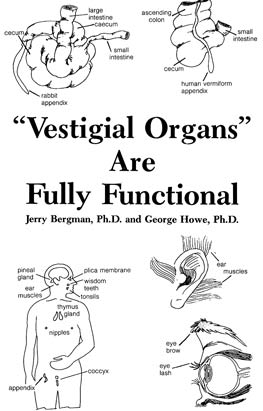
A scientific study of the myth of vestigial organs: "Vestigial Organs" Are Fully Functional.
For a long time, the concept of "vestigial organs" appeared frequently in evolutionist literature as "evidence" of evolution. Eventually, it was silently put to rest when this was proved to be invalid. But some evolutionists still believe in it, and from time to time someone will try to advance "vestigial organs" as important evidence of evolution.
The notion of "vestigial organs" was first put forward a century ago. As evolutionists would have it, there existed in the bodies of some creatures a number of non-functional organs. These had been inherited from progenitors and had gradually become vestigial from lack of use.
The whole assumption is quite unscientific, and is based entirely on insufficient knowledge. These "non-functional organs" were in fact organs whose "functions had not yet been discovered." The best indication of this was the gradual yet substantial decrease in evolutionists' long list of vestigial organs. S. R. Scadding, an evolutionist himself, concurred with this fact in his article "Can vestigial organs constitute evidence for evolution?" published in the journal Evolutionary Theory:
Since it is not possible to unambiguously identify useless structures, and since the structure of the argument used is not scientifically valid, I conclude that 'vestigial organs' provide no special evidence for the theory of evolution.305
The list of vestigial organs that was made by the German Anatomist R. Wiedersheim in 1895 included approximately 100 organs, including the appendix and coccyx. As science progressed, it was discovered that all of the organs in Wiedersheim's list in fact had very important functions. For instance, it was discovered that the appendix, which was supposed to be a "vestigial organ," was in fact a lymphoid organ that fought infections in the body. This fact was made clear in 1997:
Other bodily organs and tissues—the thymus, liver, spleen, appendix, bone marrow, and small collections of lymphatic tissue such as the tonsils in the throat and Peyer's patch in the small intestine—are also part of the lymphatic system. They too help the body fight infection.306
It was also discovered that the tonsils, which were included in the same list of vestigial organs, had a significant role in protecting the throat against infections, particularly until adolescence. It was found that the coccyx at the lower end of the vertebral column supports the bones around the pelvis and is the convergence point of some small muscles and for this reason, it would not be possible to sit comfortably without a coccyx.
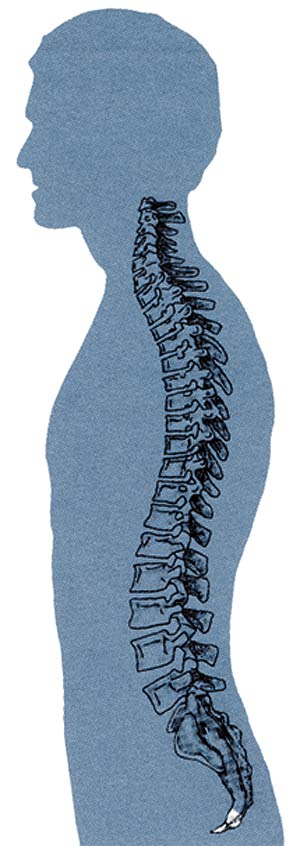
The coccyx at the lower end of the vertebral column is also not a vestigial organ but provides an attachment for our pelvic organs so that they will not collapse.
In the years that followed, it was realized that the thymus triggered the immune system in the human body by activating the T cells, that the pineal gland was in charge of the secretion of some important hormones such as melatonin, which inhibits secretion of luteinizing hormone, that the thyroid gland was effective in providing steady growth in babies and children and in metabolism and body activity, and that the pituitary gland controlled skeletal growth and the proper functioning of the thyroid, adrenals, and reproductive glands. All of these were once considered to be "vestigial organs." Finally, the semi-lunar fold in the eye, which was referred to as a vestigial organ by Darwin, has been found in fact to be in charge of cleansing and lubricating the eyeball.
There was a very important logical error in the evolutionist claim regarding vestigial organs. As we have just seen, this claim was that the vestigial organs in living things were inherited from their ancestors. However, some of the alleged "vestigial" organs are not found in the species alleged to be the ancestors of human beings! For example, the appendix does not exist in some ape species that are said to be ancestors of man. The famous biologist H. Enoch, who challenged the theory of vestigial organs, expressed this logical error as follows:
Apes possess an appendix, whereas their less immediate relatives, the lower apes, do not; but it appears again among the still lower mammals such as the opossum. How can the evolutionists account for this?307
Beside all of this, the claim that an organ which is not used atrophies and disappears over time carries a logical inconsistency within it. Darwin was aware of this inconsistency, and made the following confession in The Origin of Species:
There remains, however, this difficulty. After an organ has ceased being used, and has become in consequence much reduced, how can it be still further reduced in size until the merest vestige is left; and how can it be finally quite obliterated? It is scarcely possible that disuse can go on producing any further effect after the organ has once been rendered functionless. Some additional explanation is here requisite which I cannot give.308
Simply put, the scenario of vestigial organs put forward by evolutionists contains a number of serious logical flaws, and has in any case been proven to be scientifically untrue. There exists not one inherited vestigial organ in the human body.
Yet Another Blow To "Vestigial Organs": The Leg of the Horse
The latest blow to the myth of vestigial organs comes from a recent study on the leg of the horse. In an article in the 20-27 December 2001 issue of the journal Nature, titled "Biomechanics: Damper for bad vibrations," it is noted that "Some muscle fibres in the legs of horses seem to be evolutionary leftovers with no function. But in fact they may act to damp damaging vibrations generated in the leg as the horse runs." The article reads as follows:
Horses and camels have muscles in their legs with tendons more than 600 millimetres long connected to muscle fibres less than 6 millimetres long. Such short muscles can change length only by a few millimetres as the animal moves, and seem unlikely to be of much use to large mammals. The tendons function as passive springs, and it has been assumed that the short muscle fibres are redundant, the remnants of longer fibres that have lost their function over the course of evolution. But Wilson and colleagues argue… that these fibres might protect bones and tendons from potentially damaging vibrations….
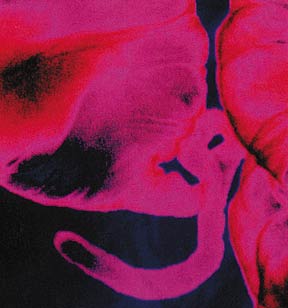
The appendix (above), which evolutionists thought to be a vestigial organ, has now been understood to play an important part in the body's immune system.
Their experiments show that short muscle fibers can damp the damaging vibrations following the impact of a foot on the ground. When the foot of a running animal hits the ground, the impact sets the leg vibrating; the frequency of the vibrations is relatively high—for example, 30–40 Hz in horses—so many cycles of vibration would occur while the foot was on the ground if there were no damping.
The vibrations might cause damage, because bone and tendon are susceptible to fatigue failure. Fatigue in bones and tendons is the accumulation of damage resulting from repeated application of stresses. Bone fatigue is responsible for the stress fractures suffered by both human athletes and racehorses, and tendon fatigue may explain at least some cases of tendonitis. Wilson et al. suggest that the very short muscle fibres protect both bones and tendons from fatigue damage by damping out vibrations…309
In short, a closer look at the anatomy of the horse revealed that the structures that have been considered as nonfunctional by evolutionists have very important functions.
In other words, scientific progress demonstrated that what was considered to be evidence for evolution is in fact evidence for creation. Evolutionists should be objective and evaluate scientific findings reasonably. The Nature article comments as follows:
Wilson et al. have found an important role for a muscle that seemed to be the relic of a structure that had lost its function in the course of evolution. Their work makes us wonder whether other vestiges (such as the human appendix) are as useless as they seem.310
This is not surprising. The more we learn about nature, the more we see the evidence for creation. As Michael Behe notes, "the conclusion of design comes not from what we do not know, but from what we have learned over the past 50 years."311 And Darwinism turns out to be an argument from ignorance.
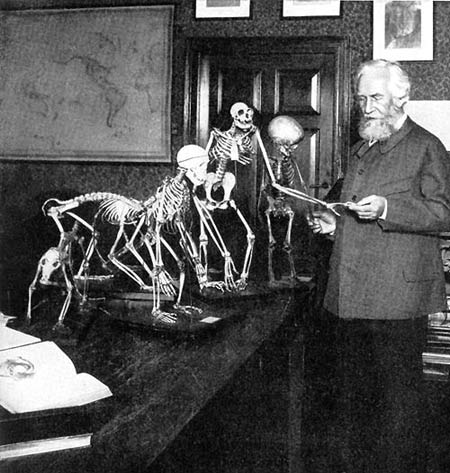
With his faked embryo drawings, Ernst Haeckel deceived the world of science for a century.
What used to be called the "recapitulation theory" has long been eliminated from scientific literature, but it is still being presented as a scientific reality by some evolutionist publications. The term "recapitulation" is a condensation of the dictum "ontogeny recapitulates phylogeny," put forward by the evolutionary biologist Ernst Haeckel at the end of the nineteenth century.
This theory of Haeckel's postulates that living embryos re-experience the evolutionary process that their pseudo-ancestors underwent. He theorized that during its development in its mother's womb, the human embryo first displayed the characteristics of a fish, and then those of a reptile, and finally those of a human.
It has since been proven that this theory is completely bogus. It is now known that the "gills" that supposedly appear in the early stages of the human embryo are in fact the initial phases of the middle-ear canal, parathyroid, and thymus. That part of the embryo that was likened to the "egg yolk pouch" turns out to be a pouch that produces blood for the infant. The part that was identified as a "tail" by Haeckel and his followers is in fact the backbone, which resembles a tail only because it takes shape before the legs do.
These are universally acknowledged facts in the scientific world, and are accepted even by evolutionists themselves. Two leading Darwinists, George Gaylord Simpson and W. Beck have admitted:
Haeckel misstated the evolutionary principle involved. It is now firmly established that ontogeny does not repeat phylogeny.312
The following was written in an article in New Scientist dated October 16, 1999:
[Haeckel] called this the biogenetic law, and the idea became popularly known as recapitulation. In fact Haeckel's strict law was soon shown to be incorrect. For instance, the early human embryo never has functioning gills like a fish, and never passes through stages that look like an adult reptile or monkey.313

In its September 5, 1997, issue, the famous journal Science published an article revealing that Haeckel's embryo drawings had been falsified. The article described how the embryos were in fact very different from one another.
Observations in recent years have revealed that embryos of different species do not resemble each other, as Haeckel had attempted to show. The great differences between the mammal, reptile and bat embryos above are a clear instance of this.
In an article published in American Scientist, we read:
Surely the biogenetic law is as dead as a doornail. It was finally exorcised from biology textbooks in the fifties. As a topic of serious theoretical inquiry it was extinct in the twenties…314
Another interesting aspect of "recapitulation" was Ernst Haeckel himself, a faker who falsified his drawings in order to support the theory he advanced. Haeckel's forgeries purported to show that fish and human embryos resembled one another. When he was caught out, the only defense he offered was that other evolutionists had committed similar offences:
After this compromising confession of 'forgery' I should be obliged to consider myself condemned and annihilated if I had not the consolation of seeing side by side with me in the prisoner's dock hundreds of fellow - culprits, among them many of the most trusted observers and most esteemed biologists. The great majority of all the diagrams in the best biological textbooks, treatises and journals would incur in the same degree the charge of 'forgery,' for all of them are inexact, and are more or less doctored, schematised and constructed.315
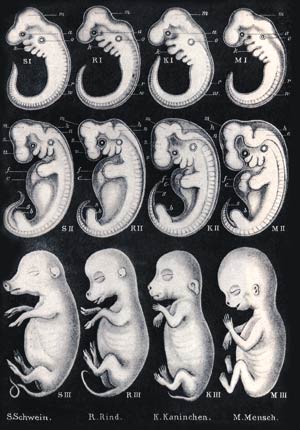
Haeckel's fake drawings.
In the September 5, 1997, edition of the well-known scientific journal Science, an article was published revealing that Haeckel's embryo drawings were the product of a deception. The article, called "Haeckel's Embryos: Fraud Rediscovered," had this to say:
The impression they [Haeckel's drawings] give, that the embryos are exactly alike, is wrong, says Michael Richardson, an embryologist at St. George's Hospital Medical School in London… So he and his colleagues did their own comparative study, reexamining and photographing embryos roughly matched by species and age with those Haeckel drew. Lo and behold, the embryos "often looked surprisingly different," Richardson reports in the August issue of Anatomy and Embryology.316
Science explained that, in order to be able to show the embryos as similar, Haeckel deliberately removed some organs from his drawings or else added imaginary ones. Later in this same article, the following information was revealed:
Not only did Haeckel add or omit features, Richardson and his colleagues report, but he also fudged the scale to exaggerate similarities among species, even when there were 10-fold differences in size. Haeckel further blurred differences by neglecting to name the species in most cases, as if one representative was accurate for an entire group of animals. In reality, Richardson and his colleagues note, even closely related embryos such as those of fish vary quite a bit in their appearance and developmental pathway. "It (Haeckel's drawings) looks like it's turning out to be one of the most famous fakes in biology," Richardson concludes.317
The Science article goes on to discuss how Haeckel's confessions on this subject were covered up from the beginning of the last century, and how the fake drawings began to be presented in textbooks as scientific fact:
Haeckel's confession got lost after his drawings were subsequently used in a 1901 book called Darwin and After Darwin and reproduced widely in English language biology texts.318
In short, the fact that Haeckel's drawings were falsified had already emerged in 1901, but the whole world of science continued to be deceived by them for a century.
299 Dr. Lee Spetner, "Lee Spetner/Edward Max Dialogue: Continuing an exchange with Dr. Edward E. Max," 2001, http://www.trueorigin.org/spetner2.asp
300 Dr. Lee Spetner, "Lee Spetner/Edward Max Dialogue: Continuing an exchange with Dr. Edward E. Max," 2001, http://www.trueorigin.org/spetner2.asp
301 Dr. Lee Spetner, "Lee Spetner/Edward Max Dialogue: Continuing an exchange with Dr. Edward E. Max," 2001, http://www.trueorigin.org/spetner2.asp
302 Dr. Lee Spetner, "Lee Spetner/Edward Max Dialogue: Continuing an exchange with Dr. Edward E. Max," 2001, http://www.trueorigin.org/spetner2.asp
303 Francisco J. Ayala, "The Mechanisms of Evolution," Scientific American, Vol. 239, September 1978, p. 64.
304 Dr. Lee Spetner, "Lee Spetner/Edward Max Dialogue: Continuing an exchange with Dr. Edward E. Max," 2001, http://www.trueorigin.org/spetner2.asp
305 S. R. Scadding, "Do 'Vestigial Organs' Provide Evidence for Evolution?," Evolutionary Theory, vol. 5, May 1981, p. 173.
306 The Merck Manual of Medical Information, Home edition, Merck & Co., Inc. The Merck Publishing Group, Rahway, New Jersey, 1997.
307 H. Enoch, Creation and Evolution, New York, 1966, pp. 18-19.
308 Charles Darwin, Origin of Species, http://www.zoo.uib.no/classics/darwin/origin.chap14.html.
309 R. Mcneill Alexander, "Biomechanics: Damper For Bad Vibrations," Nature, 20-27 December 2001.
310 R. Mcneill Alexander, "Biomechanics: Damper For Bad Vibrations," Nature, 20-27 December 2001.
311 Behe's Seminar in Princeton, 1997
312 G. G. Simpson, W. Beck, An Introduction to Biology, Harcourt Brace and World, New York, 1965, p. 241.
313 Ken McNamara, "Embryos and Evolution," New Scientist, vol. 12416, 16 October 1999. (emphasis added)
314 Keith S. Thomson, "Ontogeny and Phylogeny Recapitulated," American Scientist, vol. 76, May/June 1988, p. 273.
315 Francis Hitching, The Neck of the Giraffe: Where Darwin Went Wrong, Ticknor and Fields, New York, 1982, p. 204.
316 Elizabeth Pennisi, "Haeckel's Embryos: Fraud Rediscovered," Science, 5 September, 1997. (emphasis added)
317 Elizabeth Pennisi, "Haeckel's Embryos: Fraud Rediscovered," Science, 5 September, 1997. (emphasis added)
318 Elizabeth Pennisi, "Haeckel's Embryos: Fraud Rediscovered," Science, 5 September, 1997. (emphasis added)